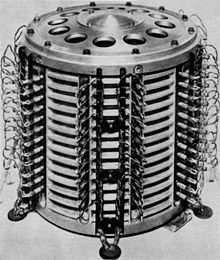Drum storage
The drum memory (English: drum memory) was an early form of data storage in computer systems , which was widespread in the 1950s and up to the 1960s and can be seen today as the forerunner of the hard disk . The method was developed by Gustav Tauschek in Austria in 1932 . On July 1, 1933, he registered his invention as an "electromagnetic memory for numbers and other information, especially for bookkeeping equipment" at the German Reich Patent Office and received patent DRP 643803. In many early computer systems, the main memory was formed by such a drum system on which Data and programs were kept during the calculation. Drum storage systems were later replaced by core storage units, which were faster and did not have any moving parts, until the introduction of semiconductor storage .
functionality
A drum storage system consists of a rotating metal cylinder that is coated on the outside with a ferromagnetic material. You can imagine the function as with a hard disk, only that the data is stored on a cylinder jacket instead of a flat disk.
A major difference to the hard disk is that the drum storage system usually has its own read / write head for each track.
At the end of the development - for example with the TR 440 - magnetic disks were also used as “drum” memories. These had a diameter of over a meter. Here, too, each track (drum or disk) had its own read / write head.
Therefore, no head movements and search times are required to drive to a certain track. The access time to a specific data record for a drum is therefore shorter, the control only has to wait until the desired data appears under the correct reading head. The performance of the drum storage system is therefore almost exclusively determined by its speed of rotation, while the speed of the head positioning is also included in the case of a hard disk.
The system clock was sometimes generated by a specially designed read head, the track of which contained a permanently magnetized pattern. This made it possible to ensure synchronous data access when executing the program's commands.
When these systems were used as main storage, throughput was the critical issue. Programmers therefore often tried to arrange code and data in an artfully optimized way on the drum in order to minimize the time span for accessing the next instruction or the next data set. For this purpose, execution times were precisely determined and the data then positioned so that the next data record passed a read head at exactly the right time. This principle was also used later as interleaving for hard disks - but there as a fixed factor in order to adapt the data rate to the processing speed of the computer.
programming
Because of the high access times, a computer with drum storage as main memory was programmed with the aid of a memory allocation plan, which was laid out as a matrix of all storage elements on the drum. The drum address of the machine command to be executed subsequently was specified in the command code in order to reach the next machine command as early as possible after the execution time determined by a table of command runtimes. This computer-related, laborious programming was replaced with the development of the hardware around 1965 by the use of higher programming languages such as Algol 60 .
power
Typical average performance values of drum storage systems:
- Average access time: 10 ms
- Average data rate: 10 Mbit / s
- Storage capacity : 10 Mbit
Web links
Individual evidence
- ↑ Patent DE643803 : Electromagnetic memory for numbers and other information, especially for bookkeeping equipment . Published April 17, 1937 , inventor: Gustav Tauschek (US priority August 4, 1932).
- ↑ Wilfried de Beauclair: Calculating with machines: A picture history of computing technology . Springer, 2005, ISBN 3-540-24179-5 , pp. 238 ( limited preview in Google Book Search [accessed January 9, 2017]).
- ^ David C. Evans: Circuit logic and memory of digital computing systems . In: H. Schultze (Ed.): Information, Computer and Artificial Intelligence . Umschau Verlag, Frankfurt am Main 1967, p. 41


